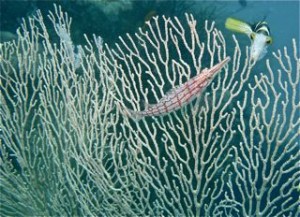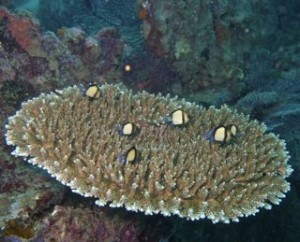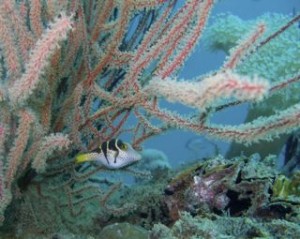Thanks to everybody who chipped in on the debate about cargo ship vs flying from Hong Kong to Long Beach. I was absolutely gobsmacked at the response – I had no idea it would prove to be such an emotive and discussion-provoking question. It was especially interesting to get the facts and figures – thank you, Christopher and Doug. (Some more interesting facts and figures on cargo ships from Wikipedia.)
Who would have thought that anything could emit as much CO2 as air travel? But it seems it’s true – which should make us all think twice about what is inside all those containers – and whether we are buying those things that are being shipped halfway around the world. If we are, we should be factoring that into our carbon footprint calculations as well as our transport choices – and, ideally, avoiding buying imported items whenever possible.
As to my decision, I was discussing my dilemma with a friend on the dive boat today. She remarked that when I talked about the cargo ship, I lit up with enthusiasm. The plane, not so much. I realized that I was actually looking forward to a couple of weeks of “vacation” to spend on writing my book and preparing my presentation. I always think best when I travel, and two weeks of time for blue-sky-thinking (or blue-sea-thinking) would be a welcome break between my speaking engagements in Asia and the start of the tour of North America.
Also, having discussed cargo ship schedules with a local businessman last night, I am now better informed about how this world works. Captains have a powerful incentive to stick to schedule, because if they miss their berth in one port then their whole itinerary is disrupted. So I am reasonably reassured that I would not be late for Asheville.
Maybe it wasn’t such a great idea to ask this question online, because I am bound to disappoint at least some of those who express an opinion. There again, it has been an eye-opening experience for me, and hopefully for some of you, too.
On a less contentious issue, here are some photos from my dive today on the wreck of the Henry Lee here in Madang. I’m just starting out in underwater photography, using a Canon G9 given to me by a very kind friend, but I’m really enjoying it. It brings a whole new dimension to my diving, making me look more carefully at this amazing underwater seascape. Aren’t ocean creatures beautiful!
But I’m ashamed to say I don’t know the names of most of the fish. The little red and white fella is a long-nosed hawkfish, and the orange and white stripey ones are anemonefish – but kudos to anybody who can help me identify the other chappies!
PS from Rita Savage:
Grateful thanks for donations sent in recently by Stanley Miller, Doug Grandt, Malcolm Brookes, Lisa Gegner, Richard Magahiz, Ian Baker, Cristof Bals, Ethem Erginöz, Ian Hamaby, Gigi Brisson, Robert, Rebecca Schwartz and one or two others not named here – you know who you are.
Also extremely grateful to those who signed up to make regular monthly payments to Roz and continue to do so, faithfully, month after month. Very much appreciated.
May I also add my thanks for the support and gratitude expressed to me during the time that I was transcribing Roz’s blogs. Very best wishes to all Rozlings!











Fantastic photos – the sea looks so healthy here as well. Another negative with the amount of junk that we don’t actually need that gets shipped around the world in containers is the number of containers that are lost at sea and float just under the surface. WOnder if there are stats on this?
Don’t fret that you’ll disappoint me, if you take the ship. People who don’t breed get a free carbon pass in my book. It’s like eliminating 100% of the CO2 footprint of your (forgone) progeny.
Plus, if you planned to spend 16 days writing in seclusion anyway, it’s hard to beat $75/day room and board on the ship (i.e. the difference between $2,100 for the boat and $900 for the plane).
Plus, the experience sounds valuable.
Isn’t it cool how God made everything so colorful under the oceans? I mean it’s something hidden, in a way, to most of us and yet the beauty He gave sea life is astounding! He thought of everything–how cool is that?! Great job on the pictures, Roz!
No need to be ashamed at not knowing the names of the fishys! I’m designing a house (to live in) and don’t know half the technical terms needed for labelling the drawings. (Come to that I’m not clear about the terminology of ocean rowboats, either.)
Enjoy your ship experience and be sure to keep us informed. As always.
Roz, since you seem to have had your heart set on being on the boat for a couple weeks, I think you should forgo the plane and its carbon benefits, especially since liner carriers stick to a schedule and there are very few contingencies, other than a mechanical failure or severe weather. Not to rule them out of the downside, but that experience would make for a good story in itself …
The incremental fuel consumed to propel you across the sea on the Hatsu Courage is about 0.0000018 of the total 98,700 DWT. The vessel consumes on the order of 300 Metric Tonnes of Bunker C fuel a day, so if you multiply out your “share” of the fuel (for sake of a simple calculation, let’s assume you and all your trappings and luggage and food and beverages you will consume total 400 pounds), it is about 20 pounds of Bunker C. That is about 3 gallons of Bunker C which would produce about 75 pounds of CO2.
Take the boat, and don’t put yourself in the position later of thinking, “If only …”
For all the reason the pro-boat Rozlings expressed … and that’s my final answer ;-D
Oh, beautiful pix (as I run out the door for my barber appt). My son probably knows all of the names. I will consult him later this morning at my great niece’s 2nd birthday party ;-D
Hey Roz
Keep doing what you like to do best.
i.e. Keep shooting the fish (photography wise)
I am sure someone else will come along and identify the fish.
Cheers
The little guy looks like a Hawaiian Toby, how’d he get there? You’ve also got a red linckia (starfish) with a sea feather, a regal angelfish, and Christmas tree worms. Papua is famous for muck diving, but it looks as though you’re hitting the bright spots.
Enjoy your travels, Roz, and remember to get your visas for your Eurasian stops! If you ever want guided diving on Oahu, let us know.
BTW, you’ve inspired us to go solar. Next stop, two days a week biking to work!
Aloha, Stephanie
P.S. Our next under/over ocean cleanup is August 14 at ala Moana beach park, ska magic island.
Great pictures. I’d say the Damsels in the top pic are probably Reticulated Damselfish (Dascyllus reticulatus). Nice shot of the Regal Angel (Pygoplites diacanthus). The puffer in the picture with the Longnose Hawkfish (Oxycirrhitus typus) is called a Black Saddled Toby (Canthigaster valentini). The Anemonefish might be (Amphiprion bicinctus) but there are so many anemonefish species in that region its hard to know for sure from one picture.
See if you can find yourself a kite ship. They look like fun. http://www.skysails.info/
Roz,
I weighed in on the vessel option on yesterday’s June 17th blog.
I am in the container shipping business. rather than retype all of it
here, refer to my posting for the Onmiviviphile entry. The Hatsu
Courage is a direct call from Hong Kong to Long Beach. looks like a
winner
Hi Roz,
So much for the atmospheric footprint. Why not look at the other aspect as you sail back on the container ship? Try to arrange a below-decks tour during the latter part of the trip. Why? The bilge pumped continuously, directly back into the ocean, is also chock-full of pollutants. Only solid waste (most of the time) is retained aboard. Most not solid (supposedly biodegradable) waste goes overboard; from kitchen (to starve rodents and other vermin), sewage generally, and oil, grease, peeling paint chips (to mention a few) from bilge water in the orlop. Having difficulty researching stats on this – seems to be a hidden factor.
Enjoy your cruise adventure, but never stop probing. Blessings to you.
Well, I think there should be an underwater iphone with an automatic “fish-detection” app 😉
What a unique place to take photos! Very nice!
Somebody should start a discount ocean transport business/industry to inexpensively take people around the world on the water. Regular cruises can be so expensive (not knocking them they can be fun and a great way to commune with the seas) but I don’t think most people could afford to travel that way every time they wanted or needed to travel overseas. Maybe cargo sailing is the answer but its not marketed at all and most people probably don’t even know its an option.
Captain Savage
In these parts those anemone dwellers are known as Clown Fish. I think those long fish are Rass. It has been too long since I have visited the reef. I’m happy that you are taking a ship. While you’re afloat, please put your capable mind to work on this dilemma. What do you suppose will happen if they can’t stop the BP leak.
Thank you for you time.
Captain Texino
I’ve just received a bit more information about the Hatsu Courage from Cruise People in London, the company that is handling the booking for me.
“This is the description for the supercargo’s cabin:
1 single cabin, supercargo (approx. 20 sqm incl. Bathroom),
G deck, starboard / aft, 1 bed- / living room,
1 bed (2.00 x 1.20 m), shower / toilet, wardrobe, refrigerator, TV,
sitting arrangement with sofa, chair, desk, carpet,
view to the aft of the ship
As to Internet, there is no access on board but Satellite telephone and fax are available. The ship does have e-mail for ship’s business and if you are able to talk one of the officers into using it to send or receive an email that is up to them but we cannot guarantee access other than by the passenger’s own devices or in port. I am sure after your exploits that they will be willing to listen!”
Sounds really rather nice! Certainly a lot more comfortable and spacious than the accommodations on board the Brocade, that’s for sure.
And a funny “small world” story – when I linked to this article (http://thetravelersnotebook.com/how-to/how-to-travel-by-cargo-ship/) about traveling by cargo ship, I noticed that it was written by an Anna Brones. Surely not the same Anna Brones…. but yes, it was! Anna and I first met at an event in the offices of Wend Magazine while I was in Portland, and later met again to discuss social media and green issues – the speciality of her company Undersolen Media. http://undersolenmedia.com/
Turns out she travelled by cargo ship from Guadeloupe to France. Backing up Tracy’s remarks, Anna responded to my email with this information: “The sailing schedules are usually adhered to and sailing times tend to be what they say they are. The shipping industry is in fact a well oiled machine and works pretty well — which is no surprise given all that it is responsible for in our globalized world.”
As for the mention of containers falling off container ships – please don’t tell me that! At the same time as I am heading eastwards across the Pacific, the Brocade will be heading westwards to Australia in readiness for next year’s Indian Ocean crossing. Would be a bit of a disaster if she fell overboard….
Thanks for the fishy IDs – I knew the Rozlings would come up with the answers! Great job on identification.
I’m sure that if Apple’s iPhoto can recognise people’s faces, there really could be an app that would recognise fish, birds, etc, if you just pointed your iPhone at the creature – or more likely, a photo of the fish, rather than taking my iPhone underwater. I know I am a woman at one with her iPhone, but I think that would be a tad risky!
Some very knowledgeable Rozings here … you know your fishies.
Over the weekend my son Keith got all but one star.
He also knows his corals which don’t seem to be mentioned so far, so here are the corals, too:
top left: acropora coral with damsel fish (IMG_2287)
#2 left: crinoid star, “another star”, fire coral (IMG_2343)
#2 right: regal angel, leather coral (IMG_2354)
#3 left: saddle puffer, gorgonian coral (IMG_2367)
#3 right: saddle puffer, long nose hawk fish, gorgonian coral (IMG_2372)
#4 left: saddle puffer, gorgonian coral (IMG_2380)
#4 right: saddle puffer, long nose hawk fish, gorgonian coral (IMG_2383)
#5 left: saddle puffer, long nose hawk fish, gorgonian coral (IMG_2384)
#6 clown fish (IMG_2409)
#7 feather duster worm (IMG_2423)
I will never forget the very first time I snorkeled, there was a huge coral with a dozens if not hundreds (of course everything is magnified 30% underwater) of itty bitty blue fish peering out from between every lobe of the coral, a stunning iridescent blue (opposite from the rear view mirror in Jurassic Park, objects are even smaller that they appear). I had no idea what the fish or the coral were, and to this day I have no idea, but I do know it would be a shame to lose the corals and their inhabitants. Ocean acidity threatens the entire web of sea life, bottom to top.
Cheers!
Roz — your beautiful photographs caused me to weep uncontrollably. What we are losing in the Gulf is unimaginable. And now the sickest behavior ever: BP is burning endangered sea turtles alive.
Please help us stop this immediately.
CREDO ACTION is circulating a petition demanding this stop immediately.
I am passing this on. Please help get the word out.
BP is blocking the rescue of endangered sea turtles and burning them alive in “control burns” to avoid paying endangered species fines. Video from sea captain who reported this is available on
YouTube; warning: It is extremely disturbing. Animal cruelty charges should be filed.
FROM CREDO ACTION:
Dear Friend,
News has just emerged from the Gulf Coast that BP is burning endangered sea turtles alive. 1
A boat captain who has been leading efforts to rescue the endangered turtles says BP has blocked his crews from entering the areas where the animals are trapped, effectively shutting down the rescue operation.
BP is using “controlled burns” to contain the oil spill. Shrimp boats create a corral of oil by dragging together fire-resistant booms and then lighting the enclosed “burn box” on fire. If turtles are not removed from the area before the fire is lit, they are literally burned alive.
The sea turtle most affected by the Gulf of Mexico oil spill is the Kemp’s Ridley2 which is listed as endangered under the Endangered Species Act. Parties responsible for killing the endangered turtles are liable for criminal penalties that include prison and civil fines of up to $25,000 per violation.
As a result, BP perversely has a financial incentive to let the endangered turtles be incinerated rather than to allow rescue crews to cull them from the burn boxes before the
containment fires are lit.
“They ran us out of there and then they shut us down, they would not let us get back in there,” said turtle rescuer Mike Ellis in an interview with conservation biologist Catherine Craig that was posted on YouTube.com. 3
Enough is enough. Tell BP to allow the rescue boats back in and stop burning endangered sea turtles alive. Link to petition:
http://act.credoaction.com/campaign/bp_endangered_turtles/?r=5664&id=9693-2012366-xbQn3Wx
Thank you for working for a better world.
Becky Bond, Political Director
CREDO Action from Working Assets
1 BP ‘burning sea turtles alive’, Raw Story, June 20, 2010
2 Sea Turtles Among Oil Spill Victims, NPR, June 10, 2010
3 Venice, Louisiana, Boat Captain/ by Catherine Craig, YouTube, June 13, 2010.
Thank you Roz, for all you do — can you please let your network know about this? –JC (hoping you can come to Olympia!)
Here in California I still get a UK paper each week and thought this might be of interest to other Rozlings:
http://www.telegraph.co.uk/earth/businessandecology/recycling/7832655/TerraCycle-The-Google-of-garbage.html